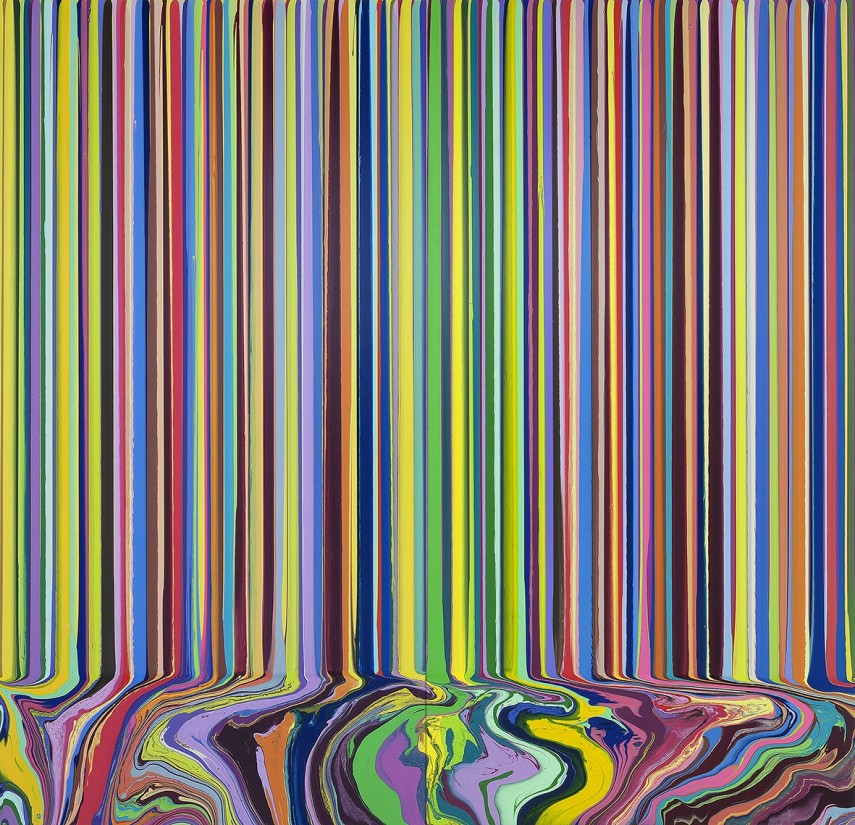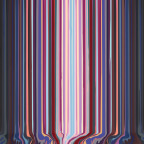Ian Davenport: Cadence
Stripes are Ian Davenport’s trademark. Multi-coloured stripes that vibrate with energy and intensity. Contiguous vertical stripes that run down the pictorial plane. However his stripes are more than simple lines of colour, and his large paintings hugely dramatic. Standing in front of them, we can see them shimmer and flutter. There is more: we can almost see the paint run and trickle, almost hear the viscous trickling and gurgling as the paint is squeezed from tubes and poured from buckets.
Colour and paint are Davenport’s obsession. The British artist studies the dynamics and movement, the way it flows and runs, drips and plops. He has experimented with novel application methods, commenting, ‘I don’t paint, I’m a conductor’. He has applied it to his grounds – usually light metal panels – with nails and syringes, and poured it from watering cans before allowing them to run, drip and trickle, interfering only very slightly with their smooth trajectories. In his Puddle Paintings, Davenport taps into controlled coincidence. Having squeezed different coloured paints from syringes placed at the top edge of the aluminium panel, he allows the paints to run downwards. At the bent lower edge of the panel, the smooth strips of paint begin to meander and flow into into each other, producing psychedelic ornamental patterns.
Davenport’s leitmotif has always been colour and paint. Born in Kent in 1966, the young Davenport, enrolled as an art student at the highly renowned Goldsmiths College. Davenport and many of his fellow art students were shaking up the art scene and would go down in recent art history as the Young British Artists.
At one point during those years, Davenport made a painting of an empty paint pot. In his introduction to a book celebrating Davenport’s first twenty-five years, ‘his friend and fellow Young British Artist Damien Hirst talks about entering Davenport’s studio at Goldsmiths College in 1987, watching him paint [...] and loving it without knowing why. “Maybe because it was empty and at that time I felt that representational painting was empty; I think we all did.”’
As he focuses on paint and colour, Davenport not only responds to vibrations of the Zeitgeist, he also works with the pulsating colours themselves. The way he paints follows rhythmical principles. He is also a musician, and has adopted Bridget Riley’s confession, ‘The music of colour, that’s what I want.’
One could say that, in more than one sense, Ian Davenport’s striped paintings are modern variations on classical themes. He greatly admires the Old Masters and the great Modernists alike, from Hans Holbein the Younger to Cézanne, and it is their colour palettes in particular, that interest him because, in his opinion, their ranges of colours work well together even though they should not. To find out exactly what palettes those artists used, Davenport has analysed digital versions of their works on the computer. Regardless of whether or not the painters or their works are famous, he is interested in the way their colours interact. In a lengthy process, Davenport then composes his own piece by orchestrating the palette of a historic painting in a new, vibrant and vivid pattern of stripes.
His compositions produce pulses of rhythm that are as stimulating as a rousing piece of music. They work very well, particularly in public spaces, where some of Davenport’s extremely large works are to be found. One such piece can currently be admired in Zurich. On scaffold sheeting that protects the Jelmoli department-store building on the corner of Uraniastrasse and Seidengasse while it undergoes a facelift, Davenport has created a work of public pop-up art. As the light changes, minute variations in the interplay of coloured stripes on 605 square metres (over 6,500 square feet) of sheeting create a fascinating melody for passers-by to absorb like an energy kick.







